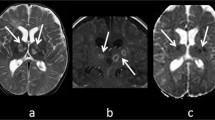Summary
67 cases of brain abscess were analyzed retrospectively. As 2 comatose patients died on admission before any treatment was started, the results are based on 65 treated patients. Different methods of treatment included: total removal in 36 patients, drainage in 14, aspiration in 6 and conservative treatment in 9. Management mortality was 18,5% and was almost not dependent on the method of treatment (except aspiration) being lowest in the drainage group. The mortality was significantly higher in patients with serious impairment of consciousness on admission.
Follow-up examination after 1 to 11 years was performed in 47 out of 53 discharged patients and revealed in 25 of them (53%) full recovery. 10 additional cases (21%) are independent. The best early and long term results were obtained in patients by drainage and medical treatment.
Chronic epilepsy developed in 34% of patients with supratentorial lesions. The risk of epilepsy was lowest in the group of patients treated by drainage.
The authors present the opinion that removal of brain abscess is necessary only in exceptional cases.
Similar content being viewed by others
References
Arseni C, Ciurea AV (1981) Brain abscesses. Comments with reference to 810 cases. Zbl Neurochirurgie 42: 77–86
Beller AJ, Sahar A, Praiss I (1973) Brain abscess. Review of 89 cases over a period of 30 years. J Neurol Neurosurg Psychiatry 36: 757–768
Barsoum AH, Lewis MC, Canillo KI (1981) Nonoperative treatment of multiple brain abscesses. Surg Neurol 16: 283–287
Basauri L, Zuleta P, Olivares A (1983) Micro-abscesses and presumptive inflammatory nodules of the brain. Acta Neurochir (Wien) 68: 27–32
Berg B, Franklin G, Cuneo R, Boldrey E, Shemling B (1978) Nonsurgical cure of brain abscess: early diagnosis and followup with computed tomography. Ann Neurol 3: 974–978
Bidziński J, Koszewski W (1988) Zachowawcze leczenie ropni mózgu. Neur Neurochir Pol XXII (XXXVIII) 4: 325–329
Choróbski J, Kunićki A (1948) The radical treatment of brain abscess. Surg Gynecol Obstet 86: 230–246
Dandy WE (1926) Treatment of chronic abscess of the brain by tapping. Preliminary note. JAMA 87: 1477–1478
Kamin M, Biddle D (1981) Conservative management of focal intracerebral infection. Neurology 31: 103–106
Le Beau J, Creissard P, Harispe L, Redondo A (1973) Surgical treatment of brain abscess and subdural empyema. J Neurosurg 38: 198–203
Macewen W (1893) Pyogenic infective diseases of the brain and spinal cord. Meningitis, abscess of the brain, infective sinus thrombosis. J Maclehose & Sons, Glasgow
Maurice-Williams RS (1987) Experience with “open evacuation of pus” in the treatment of intracerebral abscess. Br J Neurosurg 1: 343–351
Morgan H, Wood MW, Murphey F (1973) Experience with 88 consecutive cases of brain abscesses. J Neurosurg 38: 698–704
Rennels MB, Woodward CL, Robinson WL, Gumbinas MT, Brenner JJ (1983) Medical cure of apparent brain abscesses. Pediatrics 72: 220–224
Rosenblum ML, Hoff JT, Norman D, Weinstein PR, Pitts LH (1978) Decreased mortality from brain abscesses since advent of computerized tomography. J Neurosurg 49: 658–668
Rosenblum ML, Hoff JT, Norman D, Edwards MS, Berg BO (1980) Nonoperative treatment of brain abscesses in selected high—risk patients. J Neurosurg 52: 217–225
Rosenblum ML, Mampalam TJ, Pons VG (1986) Controversies in the management of brain abscesses. Clin Neurosurg 33: 603–632
Rousseaux M, Lesoin F, Destee A, Petit H (1985) Long term sequelae of hemispheric abscesses as a function of treatment. Acta Neurochir (Wien) 74: 61–67
Scott DF (1985) Left and right cerebral hemisphere differences in the occurrence of epilepsy. Br J Med Psychol 58 (Pt 2): 189–192
Stroobandt G, Zech F, Thauvoy C, Mathurin P, de Nijs C, Gilliard C (1987) Treatment by aspiration of brain abscesses. Acta Neurochir (Wien) 85: 138–147
van Alphen HAM, Dreissen JJR (1986) Brain abscess and subdural empyema: factors influencing mortality and the results of various surgical techniques. J Neurol Neurosurg Psychiatry 39: 481–490
Vincent C (1936) Sur une méthode de traitement des abcès subaigus des hémishères cérébraux: large décompression puis ablation en masse sans drainage. Gaz méd de France 43: 93–96
Westcombe DS, Dorsch NWC, Teo CH (1988) Management of cerebral abscess in adolescents and adults. Experience in the CT-scan Era. Acta Neurochir (Wien) 95: 85–89
Whelan MA, Hilal SK (1980) Computed tomography as a guide to diagnosis and followup of brain abscesses. Radiology 135: 663–671
Author information
Authors and Affiliations
Rights and permissions
About this article
Cite this article
Bidziński, J., Koszewski, W. The value of different methods of treatment of brain abscess in the CT era. Acta neurochir 105, 117–120 (1990). https://doi.org/10.1007/BF01669993
Issue Date:
DOI: https://doi.org/10.1007/BF01669993




